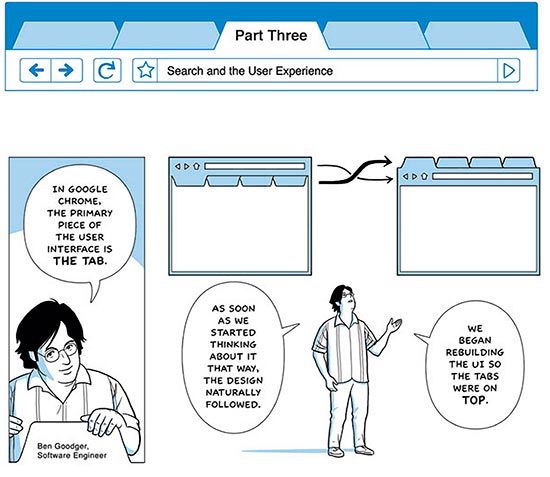BitDepth 656 - December 02
01/12/08 20:46 Filed in: BitDepth - December 2008
Google's Chrome tries to bring multi-tasking to the browser.
Google polishes the web browser

Google commissioned comics auteur Scott McCloud to create an online comic that explains how they created their new browser Chrome.
Does the Internet really need another way to view web pages? Now that Firefox is proving to be a real alternative to the entrenched paradigm of Internet Explorer, web users were enjoying both a resurgence in development that’s sure to improve rendering standards for web pages and keep competition alive.
Apple has ported its own web browser, Safari, to Windows and now the 800-pound gorilla of the Internet has decided that along with indexing the web, they would like to present it too.
Google has more at stake here than offering a browser alternative. The company’s Google Gears extension allows both Internet Explorer and Firefox to use online applications like Google Docs without an active Internet connection, but that user experience is still governed by the stability of the user’s browser. A browser crash halfway through a key e-mail or document is quite likely to sour users on using the company’s web delivered software.
Polishing Chrome
The company set about building its own alternative, Chrome. This is a web browser that has as one of its goals the reduction of what developers refer to as “chrome” the tool bars, search box and buttons that are not part of the core reason for using the software.
Google auditioned web rendering engines and chose Webkit, the open source rendering engine at the heart of Apple’s Safari.
Launch Chrome (still only available as a beta for Windows) and you find a spare window, with the tabs curiously placed at the very top of the window, above the text bar that you use to enter the web URL.
 There’s been a lot of thinking behind this inversion of tab placement and it has to do with the way that Google has engineered Chrome to manage loading and displaying pages.
There’s been a lot of thinking behind this inversion of tab placement and it has to do with the way that Google has engineered Chrome to manage loading and displaying pages.
Web browsers work like most other software, adding windows to the general overhead of running an application. Some crazed maniacs who routinely keep dozens of web pages open for offline reading (mea culpa, current count, 153) don’t take kindly to a single misbehaving website taking down an entire browser session.
Coding the browser
Perhaps the biggest change that Chrome makes to the way browsers render pages on the Internet is to treat each page as a separate process, sandboxed from the other tabbed pages you might have open. This way, if a web page crashes or freezes; you can just quit the tab without crashing the browser.
You can open a task manager that will tell you how memory and processor use each page is taking up. If this isn’t a way for Google to establish the browser as its own operating system, then I don’t know what is.
There’s a lot more under the hood going on in Chrome and some of it is quite complicated. To tell their story, Google hired Scott McCloud to create a comic that reinterprets conversations with Google developers in an interesting way.
It’s an intriguing work, but we’re still talking about “deallocated memory” and “class transitions,” so don’t expect many giddy laughs from this online graphic entertainment.
Links
Scott McCloud’s Chrome comic
Google’s Chrome beta for Windows

Google commissioned comics auteur Scott McCloud to create an online comic that explains how they created their new browser Chrome.
Does the Internet really need another way to view web pages? Now that Firefox is proving to be a real alternative to the entrenched paradigm of Internet Explorer, web users were enjoying both a resurgence in development that’s sure to improve rendering standards for web pages and keep competition alive.
Apple has ported its own web browser, Safari, to Windows and now the 800-pound gorilla of the Internet has decided that along with indexing the web, they would like to present it too.
Google has more at stake here than offering a browser alternative. The company’s Google Gears extension allows both Internet Explorer and Firefox to use online applications like Google Docs without an active Internet connection, but that user experience is still governed by the stability of the user’s browser. A browser crash halfway through a key e-mail or document is quite likely to sour users on using the company’s web delivered software.
Polishing Chrome
The company set about building its own alternative, Chrome. This is a web browser that has as one of its goals the reduction of what developers refer to as “chrome” the tool bars, search box and buttons that are not part of the core reason for using the software.
Google auditioned web rendering engines and chose Webkit, the open source rendering engine at the heart of Apple’s Safari.
Launch Chrome (still only available as a beta for Windows) and you find a spare window, with the tabs curiously placed at the very top of the window, above the text bar that you use to enter the web URL.

Web browsers work like most other software, adding windows to the general overhead of running an application. Some crazed maniacs who routinely keep dozens of web pages open for offline reading (mea culpa, current count, 153) don’t take kindly to a single misbehaving website taking down an entire browser session.
Coding the browser
Perhaps the biggest change that Chrome makes to the way browsers render pages on the Internet is to treat each page as a separate process, sandboxed from the other tabbed pages you might have open. This way, if a web page crashes or freezes; you can just quit the tab without crashing the browser.
You can open a task manager that will tell you how memory and processor use each page is taking up. If this isn’t a way for Google to establish the browser as its own operating system, then I don’t know what is.
There’s a lot more under the hood going on in Chrome and some of it is quite complicated. To tell their story, Google hired Scott McCloud to create a comic that reinterprets conversations with Google developers in an interesting way.
It’s an intriguing work, but we’re still talking about “deallocated memory” and “class transitions,” so don’t expect many giddy laughs from this online graphic entertainment.
Links
Scott McCloud’s Chrome comic
Google’s Chrome beta for Windows
blog comments powered by Disqus

